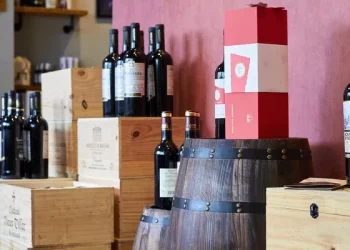At Eberbach Abbey in the German state of Rheingau, the Cistercian monks used to keep their best wines in special cabinets and open them only when honored guests visited, so they called them “Kabinett Wein” — little house wines.
The term “house wine” first appeared in books in 1712, and even today, although the definition of a wine made from German Riesling is clear, many people don’t know how it works.
However, as a symbol of high quality wine, the house wine is very high in the German heart.
The reason why people do not have a comprehensive understanding of the house wine is because of the complexity of the German wine classification system.
This system is based on the density of grape juice, which is often referred to as Oechele.
When the grape ripeness is higher, the sugar content is higher, and the Oechele value is higher.
German wines are classified into five grades according to the level of Oeschle (the density of grape juice), with house wines having the lowest Oeschle (the grapes are the least ripeness and have the lowest sugar content),
This was followed by selected wine (Auslese), late picked wine (Spatlese), selected wine by grain (BA) and selected wine by grain (TBA).
Each grade has a strict Oeschle range. For example, the lowest Oeschle value for a small house wine is between 73 and 78 degrees.
You might think that with all this sugar, the wine would be sweet, right?
In fact, this understanding is wrong.
German wine grades are based on the sugar content of the grape juice, not the remaining sugar in the wine.
Only if the wine is high in residual sugar will it give the taster a sweet taste.
A German wine specialist said: “The yeast breaks down the sugar into alcohol and carbon dioxide and gives off heat, so we can get a rough estimate of the amount of sugar left in the wine based on the alcohol content on the label.”
A small house wine, for example, with 10%ABV, has about 35g/l of sugar left.
However, the Oeschle value is a minimum standard for the density of grape juice. There is no upper limit at all, so winemakers can use grapes with higher sugar content to make house wines, which of course have higher residual sugar and alcohol, but can also be dry wines.
As a result, people, especially foreigners, do not know much about German wine.
For someone who doesn’t understand wine or German, this hierarchy is no guide at all.
Not so the Germans, who export very little of the wine they make and consume 80% of it for domestic drinkers.
For Peter Karsten, winemaker at Gut Hermannsberg, Germany, the way to understand house wine is not just through cold technical data but logically, preferably as a grape style,
This wine is made from grapes that are neither too ripe nor too green. It has a low alcohol content, but the wine is of high quality.
All in all, regardless of the Oeschler value or the sugar content of the grapes, Riesling is a particular style of wine, not a set of technical statistics.
This wine can be semi-dry, semi-sweet, and of course dry. It is a refreshing, lively, fruity, well-balanced wine that tastes like a spring breeze and adds wings to a tiger.
The latest market dynamics at any time to see, please pay attention to.












































